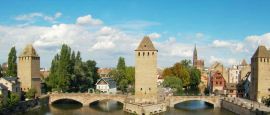Considered the world's tallest building from 1647 to 1874, and still the sixth tallest church today, this richly decorated gothic masterpiece of pink-tinted Vosges sandstone stands proud with its steeple reaching 142m (466ft) which is visible far across the plains of Alsace. Highlights include the intricate west facade with its three portals; the Eglise and Synagogue statues (the originals are located at the Musée de l'Oeuvre Notre-Dame); and the remarkable Renaissance Horloge Astronomique (Astronomical Clock), one of the world's largest clocks, which chimes at 1230 daily, as the Apostles parade before Jesus. The outstanding views of the city from the top platform are well worth the 330 arduous steps.
Things to see in Strasbourg
Tourist offices
Address: 17 place de la Cathédrale, Strasbourg, France
Tel: 03885 22828.
Opening Hours:Daily 0900-1900. www.otstrasbourg.fr
You can buy a Strasbourg-Pass at the tourist office and in hotels. Valid for three days, the pass offers free entries and discounts to museums and attractions.
The Passe des Musées du Rhin Supérieur (tel: (03) 8852 5000; www.museumspass.com/en), allows free access to 190 museums in the area of Rhin Supérieur, including Strasbourg. You can buy the pass online or at any participating museum and access all the listed museums.
As in many French cities, Strasbourg's museums offer free admission on the first Sunday of every month.
This museum, with its glass facade looking out onto the quayside, is an ultra-modern addition to Strasbourg's buildings and contrasts sharply with neighbouring Petite France. The impressive permanent collection of paintings from the 1860s to the 1950s includes work by Monet, Signac, Arp, Picasso, Magritte and Klimt. From the 1950s to the present day, Brecht, Filliou, Pérez and Manetas are represented. There is also an art library, concert hall and restaurant.
The original pair of statues of Eglise (a symbol of the victorious Church) and the blindfolded, defeated Synagogue (representing Judaism), are the main treasures of this museum. Other highlights include the Tête du Christ (Head of Christ), part of a stained-glass window from the mid-11th century, the sculptures of Nicolas Gerhaert de Leyde and the still-life paintings by Sébastien Stoskopff. This rich collection of Romanesque, gothic and Renaissance sculptures, furniture and tapestries extends over three floors of 14th- and 16th-century buildings.
This 18th-century baroque ‘mini-Versailles' was built as a residence for the city's French bishops, four of whom were members of the Rohan family. The château houses three important museums and a gallery. The basement is devoted to the Musée Archéologique covering the period from the Palaeolithic Age to AD800. The Musée des Arts Décoratifs, located on the ground floor, comprises the luxurious apartments of the clergy of Rohan (used as guesthouses by Louis XV and Marie-Antoinette), and a collection of Strasbourgeois clocks and china. The Musée des Beaux Arts, on the first floor, displays European paintings from the Middle Ages to 1870.
This intriguing museum of Alsatian history is housed in three 16th- and 17th-century buildings. The very varied collection illustrates pre-industrial Alsace and includes a collection of artefacts such as furniture, toys and fascinating Jewish and Christian worship items.
A recent addition to Strasbourg’s impressive list of museums is the Tomi Ungerer Museum/Centre international de l’illustration located in the former Villa Greiner. The space is dedicated to the works of Strasbourg-born artist Tomi Ungerer and displays 800 pieces, from children’s books to political caricatures and satirical cartoons. This museum offers a fresh alternative to art and provides insight into one of Strasbourg’s best-known figures.
Close to the university campus, this 18th century building is home to an impressive collection of various elements from Jean Hermann’s Gallery of Natural History, which is one of France’s richest. With pieces from the Arctic to the Antarctic, the museum showcases myriads of birds, insects and mammals that transfer old and young to imaginary worlds within the animal kingdom.
Located opposite the Palais de l'Europe, the Parc de l’Orangerie is the largest and oldest park in the city and is home to many stalks, the symbol of Strasbourg. The beautiful Pavilion Josephine, built in honour of Empress Josephine in 1804 hosts numerous events and exhibitions and is surrounded by stunning gardens and century old trees. The park offers punting in the summer, and has a zoo, a mini-farm and bowling alley – ideal for family days out.
In the 19th century, Countess Mélanie de Pourtalès hosted her high society guests in the beautiful château situated at the heart of this 24-hectare (59-acre) park. Contemporary sculptures are featured throughout the gardens and blend into the landscape. Claudio Parmiggiani's “La Forêt Regarde et Ecoute” (The Forest Watches and Listens) consists of bronze ears grafted on to tree trunks. These are cleverly fused with the piece’s natural surroundings and give a magical feel to the garden and château. With its 25 rooms, the beautiful château welcomes guests in a grandiose setting.
Do you have any Feedback about this page?
© 2025 Columbus Travel Media Ltd. All rights reserved. No part of this site may be reproduced without our written permission, click here for information on Columbus Content Solutions.








 You know where
You know where